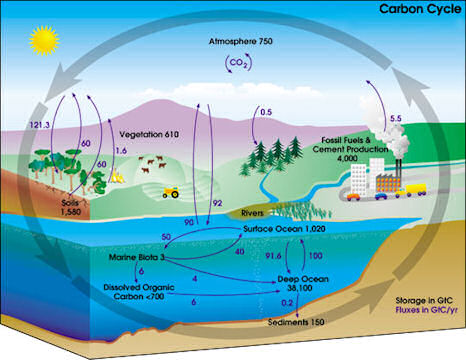Biosphere Contents
1. Organic Matter
Carbon gets into the biosphere by assimilation (as carbon dioxide) by green plants in photosynthesis
During photosynthesis, green plants absorb carbon dioxide from the atmosphere and assimilate the carbon to form organic compounds.
The opposite happens in respiration, when carbon is released into the atmosphere as carbon dioxide. It is not only plants that release carbon through respiration. Carbon is also released by the respiration of organisms that feed on plants, and by bacteria that decompose dead plant or animal tissues. Carbon may alternatively be stored as fossilised plants or animals (coal, oil and gas are carbon-based), but this is released when fossil fuels are burnt and re-enters the atmosphere as carbon dioxide.

Carbon is present in the atmosphere as carbon dioxide, currently at a concentration of around 390 ppm (parts per million by volume). In the hydrosphere it dissolves in water. Overall, there is approximately 50 times more carbon dioxide in the oceans than in the atmosphere (IPCC 2007).
Carbon dioxide in the atmosphere is in equilibrium with carbon dioxide dissolved in the oceans. This dissolved oceanic CO2 forms a weak acid which then reacts with carbonate ions to form bicarbonate ions. The more of the oceanic CO2 that can undergo this process, the more carbon dioxide that can be dissolved. Carbonate ions in the oceans mainly originate from dissolved calcium carbonate, and so over long time-scales the calcium carbonate content of water strongly influences the concentration of carbon dioxide in the atmosphere.
How does carbon get into the biosphere?